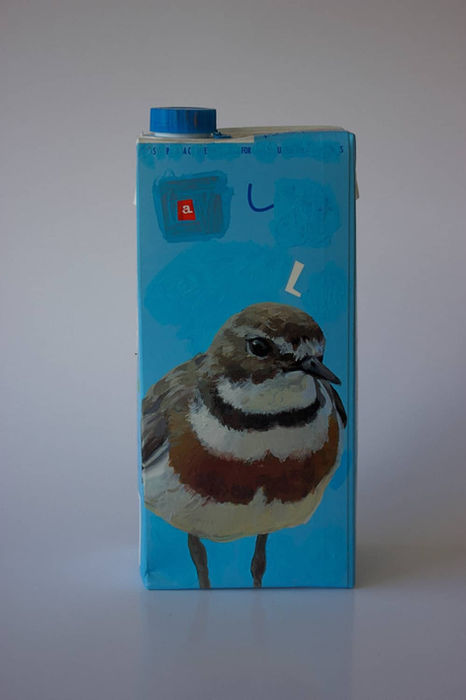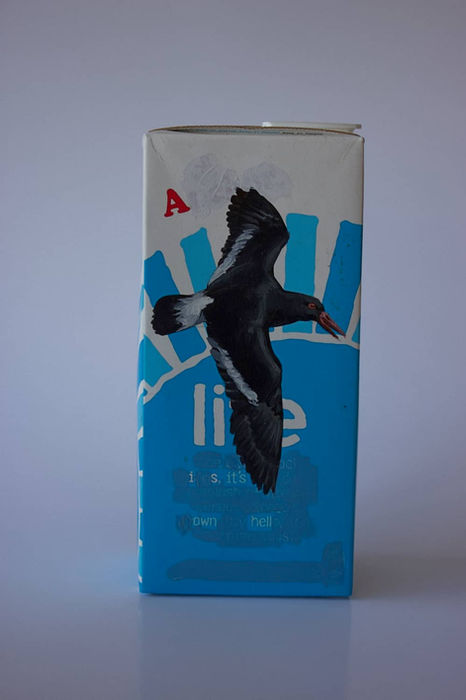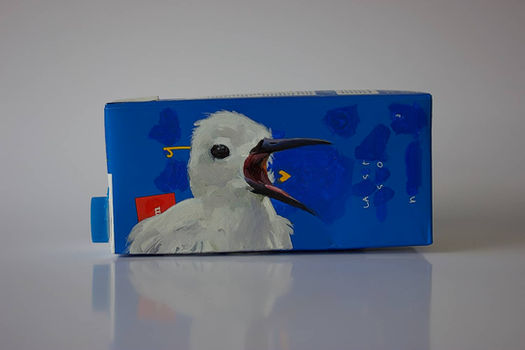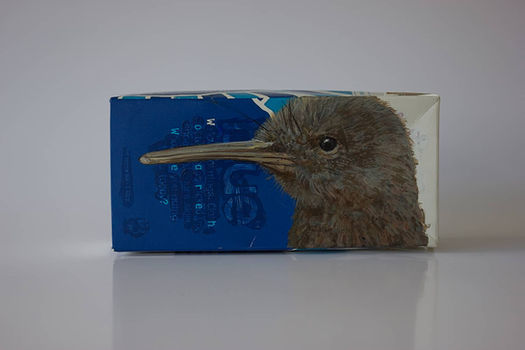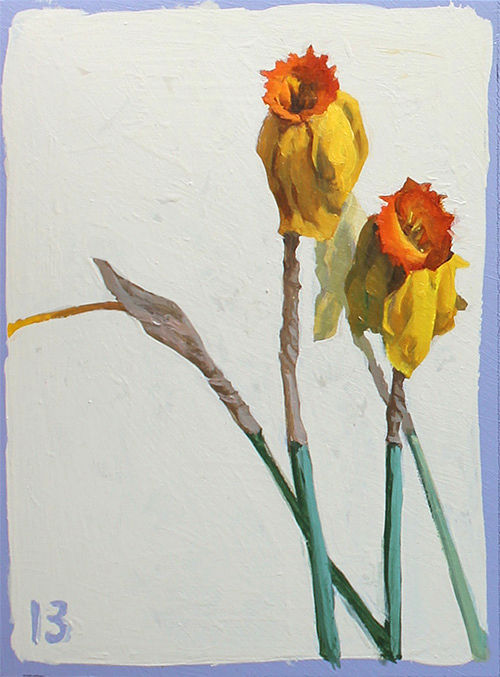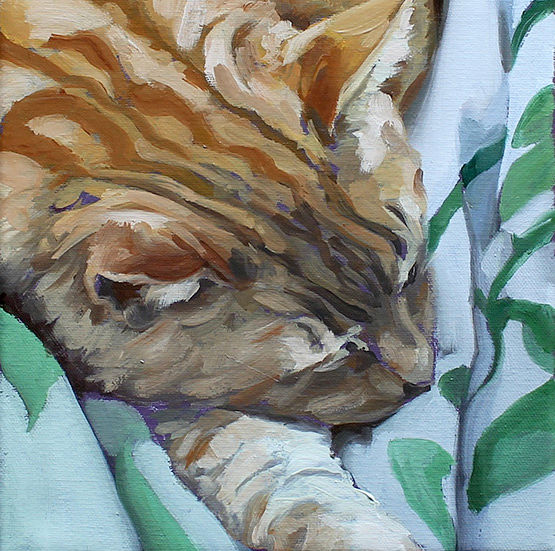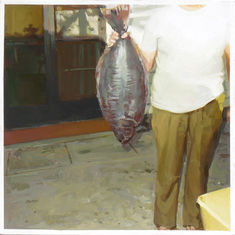Here are the projects that I have undertaken for art exhibitions or self started. They mostly reflect my concerns with the environment and our place within it.
Projects
May Day
31 new concepts created one each day for the month of May. This is a type of project that I set myself often, it is designed to stimulate new ideas and to paint loosley - cutting the fat and fiddle time by putting a time limit on the work. The idea is not to produce good painting, but to push myself into new areas via stress and time pressure.
Each prepared paper substrate measures 59 x 84cm.

Supplementary Paintings



Barry’s work explores the tension between humans’ exploitation and conservation of the environment. He used the new Galaxy S23 Ultra’s ground-breaking 200MP camera to capture unparalleled close-ups of his work, even capturing detail such as intricate brushwork, broken brush bristles, and surface texture. He then combined these images into the composite artworks which were used to create a series of unique artworks for each Samsung Studio around New Zealand.

Estranged
An exhibition at Depot Artspace with a group of recent MFA graduates with each bringing their own interpretation to the word "Estranged". The artists displaying work for this exhibition are: Barbara Smith, Rowan Belcher, Monica Seo, Ken Martin, Barry Ross Smith, Elsa Lye, Gitte Steen-Andersen and Julie Woodward.
My meditation on the show title was to consider how removed we are from anything not immediately within our consciousness. Once I throw something away, discarded into the trash, it makes its way to a landfill or the ocean and becomes invisible to me. I sometimes seem to be living as if unaware, separate and above other life forms - unthinking of the impact my privileged life is having upon my surroundings and the wildlife that shares this planet with me. The ocean, once considered vast and unending is becoming choked with human rubbish. I decided to fabricate an oversized Orange Roughy fish from Auckland Council plastic rubbish bags (60 litre orange bags). And to bring this sculpture to life by incorporating movement with a fan inside it as a bellows to inflate it and create the effect of breathing


Making the Cut
I chose an Orange Roughy because they are New Zealand's largest commercial catch, are slow-growing (maturing) with a very long lifespan (up to 200 years), resulting in low resilience to change. The early working title was: the Breath of the Moon and the idea for this came from thinking about the interconnected nature of earth and the moon. How it is the gravitational pull of the moon that creates the motion in the sea, like a breath, the sea is the lungs of the earth and we are clogging it with plastic.
Using the initial sketch to get the basic idea down on paper, A digital three dimensional version was created in Cinema 4D software. It was then exported to a 3D pattern software package where the digital construct was transformed into 3D isometric shapes (over 200 in total) and the file was printed out onto a long continuous roll of paper with all of the segments displayed to form a pattern in order to cut the shape out.

Each outline shape of the pattern had a small 10mm tag along its outside edge for attaching to the next segment - like a 3d puzzle. The next step in the process was to cut all of the pieces out of the rubbish bags, attach them to each other and then construct all of the specific pieces into a whole forming a bladder for the fan.
Orange Roughy
An electric fan was dismantled and the motor and fan used to power the air flow. An electrician was then utilized to connect the timer and mechanism to stop and start the fan at the desired intervals, which turned out to be 4 seconds. It was set to turn on for four seconds, then stop for three seconds and repeat, creating the effect of a living breathing creature.
The fish sculpture, lying on it’s side is inflated with the electric fan as an air pump. With the use of the rubbish bags, an everyday item that is designed to be discarded, the breath brings a personal focus to a larger environmental problem. Watching the Orange Roughy in process had a disturbing effect and was uncomfortable to view, it's clunky carton appearance created an empathy in me.





A Landscape without Birds
Got Milk?
This project was completed for the 100 days project. A nationwide activity bringing people from all walks of life together (via the internet) to create, one thing each day... for 100 days.
Completing the 100 days is hard. It is an exercise in consistency - no weekends off, no sick days. One thing produced each and every day for over three months. By the end I was exhausted, but I'd also gained a strong habit of daily commitment to working in my studio. It's also fascinating to scroll through the various and different projects undertaken. In 2016 over one thousand people took part but many, many fall to the wayside along the journey. The project began on the 24th August and was completed on the 1st of December 2016. Each daily creative act from all of the participants can be seen at the 100 days project website.
In America, the portraits of missing children were printed onto the side of milk cartons in an effort to get their face noticed by the general public. It was used as an aid to create awareness and hopefully find where the kids might have gone. My project encapsulated this concept by painting an image of one of New Zealand's threatened animals or plants onto the side of a commercial milk carton each day, for 100 days.
It is a sad fact that I had more than enough endangered animals in which to paint. New Zealand has over 4000 endangered plants and species! The boundaries were simple, to paint one a day as a 'warm-up' to my studio time. Not to go back over it and do any repainting once completed.
Along with the daily painting, I began to pick out a sentence from the many words printed on the carton, a saying or sentence that appealed to me, in the gallery below you can find the 'found text' next to an image of the milk carton produced that day.

Life • Still
This project is a visual idiom, a metaphor utilising the still life genre. It is less an instruction manual and more of a meditation, a contemplation upon daily existence. Each day my task was to paint a small object and then to upload an image of the painting. All the daily paintings are intended as a device for clarity and continuity within my daily practice. I completed over two months and then ran out of steam around Day 88.
August a Stone - (after Sisyphus)
A humble rock taken from my garden and placed within the studio setting then observed/painted each day for a month. There is madness in repeating the exact same thing daily, a frustration or movement towards nihilistism. But within that repetition there also meditation, rediscovery and appreciation of form, chiaroscuro, the language of light ... perhaps it is an optimistic nihilism as it became a pleasure to focus upon each days sunlight illuminating this singular small rock.
oil on canvas, 180 x 180mm each
September - Daffodils (after Spring)
A traditional still life subject; the flower bouquet. It was placed in a glass vase and without touching it was painted each day of the month of September as they slowly wilted and died. Each days painting was inscribed with the date of that session.
mixed media on board, 150 x 200mm each
October - Everyday Objects
I discovered that without an attachment, I find it difficult to connect with the content, so I tried painting household items. I ran out of inspiration around day 88 but was content with the entirety of the project as one of its aims was getting the daily ritual of painting in the studio into a habit, which it achieved.

Title: Pieces of Me. Size: 100 pieces 18 x 18 cm each. Medium: mixed media on board

Painting from Day 75, 18 x 18cm

Title: Pieces of Me. Size: 100 pieces 18 x 18 cm each. Medium: mixed media on board
Use the slider to place the painting for each day and watch it develop over the 100 days into the final portrait.
The 100 Days Project was a community arts project that was established by Emma Rogan and ran between 2011 and 2018. Held once a year, anyone, of any age and skill level could sign up to participate in this creative marathon. Participants or 'hundred dayers' as they came to be known, agreed to perform one simple creative exercise (of their own choosing) every day without a break for 100 consecutive days.
The only rules: that you could not skip a day and had to record each day's effort.
By 2018 more than 5,000 people from all over the world had taken part in the project, which culminated each year in pop-up exhibitions called 'Day 100 Shows' to showcase the resulting work. We celebrated Day 100 many times over across New Zealand and the world, including shows in Auckland, Nelson, Gisborne, Wellington, Christchurch, Melbourne, Sydney, The Netherlands and Edinburgh. Although currently on hiatus, there is a strong community of hundred dayers who now manage and organise their own projects on facebook.
My 100 Days Project
I chose to paint a self-portrait because off the tradition of oil painters to use themselves as model. If I had realised the clinical detail these small abstract panels would create, the microscopic scrutiny, I would have chosen anyone else! It makes me uncomfortable to see this work, this rendition of me, observing myself. My plan was to take a photograph, divide it up unto square segments, which because of their small size become abstracts, and then complete a daily painting mimicking the small segment. The finished work is very large (180 by 180 cm) yet due to the fact that the substrate is 100 18 x 18 cm panels - it all fits in a very small box on a shelf in my studio. To construct the finished artwork and make sense of the Rorschach inkblot looking patterns, there is a legend attached with the box with an image of each piece in its correct position.
Day 1
I began with a photograph which was divided into 10 by 10 squares (making 100 in total - one for each day). Each day I completed a new small abstract painting onto single panel - with no reference to the segment completed the day before or to the rest of the image as a whole.
All the days inbetween...
The paints used were a mix of water based acrylics with oils, creating a difficult, more spontaneous result which couldn't be easily manipulated into a form. After the first month, I began to look forward to my studio time and used the initial panel painting as a warmup to the day in the studio. Weekends were difficult at times, with other commitments, family, kids and travel all having to be incorporated into the routine.
Day 100!
By Day 100 I had accomplished the initial desire to create a daily habit of painting and the many pieces were collected for hanging. I had to develop a system to catalogue each individual piece to know it's precise location within the jigsaw of the whole. As well as being show at the 100 Day Project exhibition, my painting was exhibited in The Figure in Art - Uxbridge Creative Centre (group exhibition)
Left is one of the 100 individual paintings (Day 75), to see the entire self portrait select the slider below and move it to the right. Each days painting will move into place forming the final work.


Pink Fade, enamel and oil on board, 91 x 91cm
Part of my fascination is the anonymous journey these images have taken. The time, location and any of the participants is unknown, and unknowable. Yet they remind me of the moments that I have chosen to fix in time in my memories, the journey each of us is on and our own treasured and/or embarrassing records of our passage through life that we either cherish or ban.
I chose to honour these momentary recordings, each one a thin slice of a person's life. Due to this perceived lack of value or success, I chose images that displayed some form of failure and utilized the medium of household oil-based enamel paint to facilitate my own slippage in their creation as well as the attributes of d.i.y that enamel paint invokes.
Lost and Found
text by Peter Michael Le Fevre
In the one hundred and fifty year existence of the photographic image much has been debated regarding the photography versus painting issue. The predicted death struggle between the traditional and new methods of picture making seemed at first clear and simple. What emerged initially seemed to be that photography released painting from the burden of verisimilitude to which it was implicitly subjected. It provided painting at first the licence and then the obligation to concentrate on what photography could not do. This worked partially from the premise that photography was the honest and impartial recorder of truth and likeness; it was scientific and unflawed unlike painting with its inherent human frailty.
The moment proved fleeting and the advent of the digital era with its post-millennial fluidity of boundaries and altered images has left us with a discipline that now only retains a residual association to its original observed reality and truth. We had discovered a terra-incognito, the digital world which continually needs exploration and in which the issues of the place of photography and painting need redetermination. Add to this the layered complexities of relationships that are created by an artwork and the debate deepens. This is Barry Ross Smith's territory.
In considering photography as a medium it becomes in essence, a surreal depiction of the world as a series of disassociated bodies, like a collage or a collection of quotations, always the momentary headline and never the novel. It is a scopophilic activity in which the removal of the hand from the photographic process has concentrated all the attention to the eye, to the exclusion of all other senses. It is a process of obsessive examination of small fragments without allowing us to view or understand the whole. But in our contemporary experience this could be all that is required of it. The constant and unrelenting production of increasingly facile wallpapered imagery could herald societal decline into a state of visual ennui. Within this body of work Smith re-engages us in a revitalised debate. He selects photographs from the vast library of anonymous "lost" images that have been found and posted on the net, but which have no apparent attached history or commentary. These intriguing momento-mori recording experiences, which at the point of creation were considered of sufficient significance to be recorded, preserved with the intention of being revisited. They elicit a powerful resonance of recognition, a human empathy of a shared experience. For the viewer on first encounter there tends to be an oscillation between voyeurism and recognition. The human experience of living captured in its banal moments. These images are records of the clumsy performances of photographer and subjects that became the standardised lexicon of much recorded imagery as the technology of film photography became affordable and democratized. Smith renders these everyday images as paintings which mimic the veneer of photography hilt which upon closer inspection reveal an expressionistic, painterly approach with the artist employing an open handwriting of brushwork, which dissolves the truth of the photograph into a disintegration of marks, exposing the construction of Illusionism. Is these works both disciplines of photography and 'wilting are reinvestigated, there is no longer any lain to sovereignty of vision by either discipline; thest. have been no deaths and no longer even a vo%t ige of struggle, merely a shift in our thought and viooli. These paintings or paint rendered photographs are not images that depend on the photographic source as additional information providers but are works about processes, the artist as the magician thereby revealing his magic, layer by layer. This careful and dellberate deconstruction allows the viewer an active space to exercise a critical scrutiny and for a direct and fascinating engagement with the work.
Everyday Fictions
These paintings are 're'-representations of 'found photographs'. They are referenced by old photographs that have been sourced from garage sales, rubbish bins or roadsides and then uploaded for others to appreciate (there are entire websites dedicated solely to the collection and display of discarded photos). They depict a slice from a moment of a life that at one point was deemed worthy of a keepsake and then.. unworthy of keeping, either because of being unintentionally disposed of, forgotten, rejected or no longer required. Perhaps the original photographs were discarded as they were deemed a failure to 'capture the moment', were out of focus, poorly cropped, blurry or degraded by time. Perhaps because the content or person depicted was one that someone wished to forgotten.












































